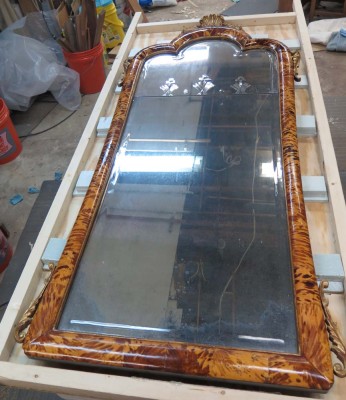
Immediately on my return from Cedar Rapids, I reloaded my duffel with clean clothes and headed off for week of work near Mordor on the Potomac. The purpose of the trip was completing the conservation of the second of the two tortoiseshell-veneer mirror frames. The process for conserving the second frame was conceptually similar to that employed for the first one a couple of months ago. The only substantive difference was that the areas of damage this time were larger but fewer and “cleaner”than for the first mirror.
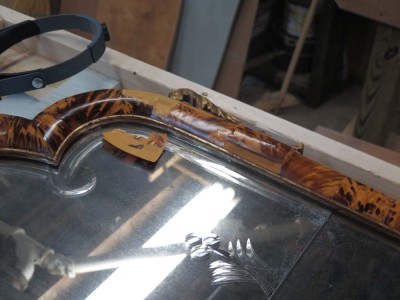
As before, once the mirror was in the work space the first task was to systematically work my way around it to document the specific areas of interest (read: damage) for the treatment.
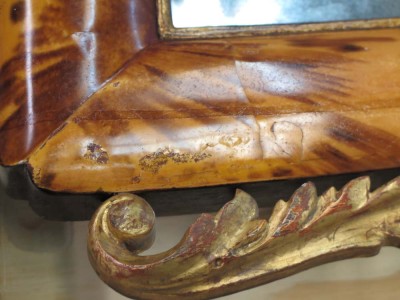
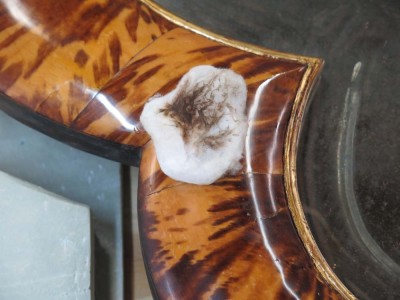
Once that was completed I proceeded to clean the surface in order to remove the accretions of oil, a traditional but ineffective, somewhat deleterious maintenance protocol and get it all ready for the next step. These depositions were dealt with easily through the damp wiping with naphtha on cosmetics pads from the pharmacy, almost instantly removing the molasses-like oil and dirt amalgam.
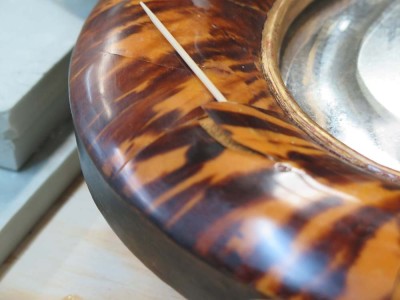
The incursion of oil underneath the lifted tortoiseshell veneers was resolved through gentle insertion of a toothpick or bamboo skewer to lift the affected area, then the insertion of blue shop paper towels and wicking them with naphtha, sometimes several times, to remove enough of the contaminating oil to render the glue margins acceptably clean.
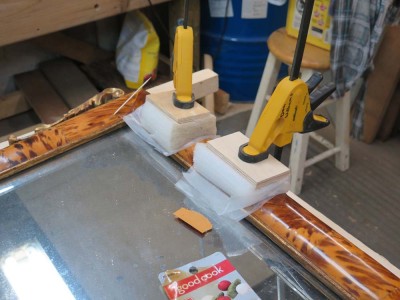
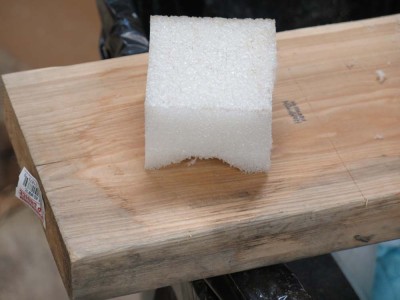
The lifted tortoiseshell was re-adhered to the frame substrate with 192 Special grade of hot animal hide glue from Milligan & Higgins, and pressed into proper configuration during gluing through the application of shaped polyethylene foam block cauls, with two pieces of food vacuum-pack wrapping membrane in between the tortoiseshell and the foam caul.
Once the glue was hard, I removed the cauls and separating membranes, cleaned off any wandering glue with distilled water on pads, then applied Mel’s Wax to the entire surface, which brought the mirror frame to life!
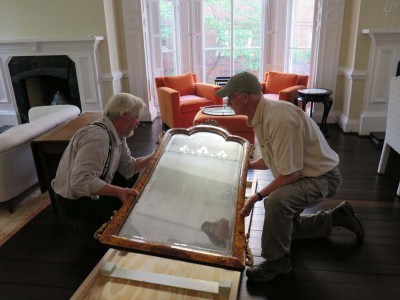
In a way, the most challenging part of the project was the transport of 300-year-old mirrors the few miles from the client’s home to my work space safely, and the handling of them at each end. To accomplish this I fabricated a custom tray/litter with XPS bumpers and supports below and above the engraved and mirrored glass, with the whole unit being suspended in air through the gentle application of winching straps.
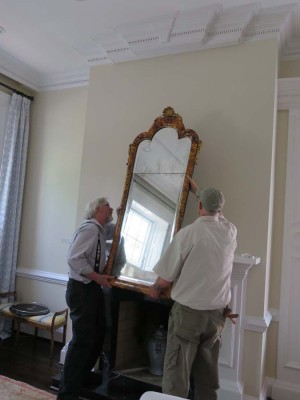
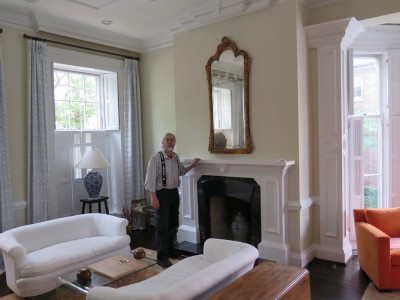
Safely completed and transported and re-hung in the client’s magnificent home, I joined the client in celebrating the project and the beauty reclaimed for the mirrors, and was delighted to be photographed alongside the second one.
On my way home from returning Mr. Studley’s treasure back to Mister Stewart, at the invitation of Narayan Nayar, the polymath who was my photographic collaborator for Virtuoso, I ventured into the alien universe of Chicago to connect with him. I have gathered many treasures along the path to getting to “done” with the book and exhibit, and his friendship is first among equals in this regard.
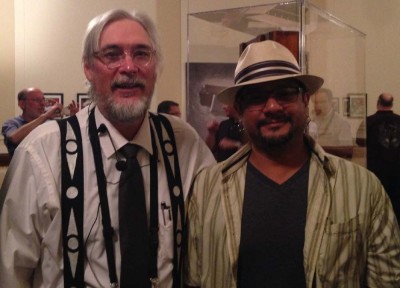
Narayan may or may not share my ambivalence towards fashion in general, but we absolutely possess an appreciation for fine hats. I’m not sure of the genesis of this proclivity for him, but for me it was growing up in Minnesota, where a hat kept your brains from freezing, followed by adolescence and early adulthood in Florida, where a hat kept your brains from frying.
The topic of hats came up periodically during our hundreds of hours working together with the Studley collection, time that was simultaneously exhilarating and bone-numbingly tedious. He noticed my hand-made beaver-fur-felt Borsalino, I noticed his hand made Optimo (although I did not know the brand, only that it was one fine looking lid.)
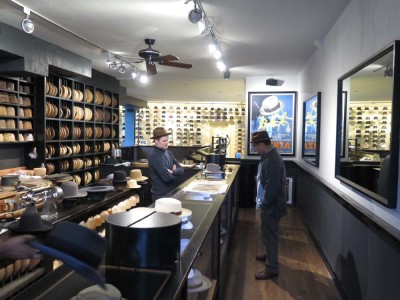
So we met up at Optimo’s hat making shop in southern Chicago. To hat aficionados, it was like Handworks was to toolaholics. I arrived a bit before Narayan, and wandered about the showroom in a near-stupor at the hat exquisiteness all around me. These were indeed the finest hats I had ever encountered. And thanks to Narayan’s beneficence I would soon be getting one myself.
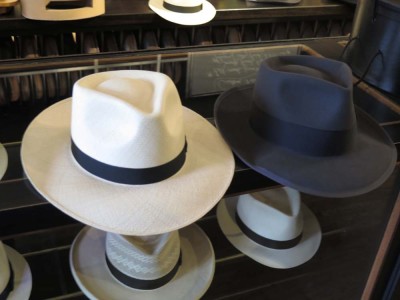
By the time he arrived a few minutes later I had narrowed down the selection to two hats, one a fedora, the other a Panama. In the end I simply could not choose, so he bought one for me and I bought the other for myself. A week later they both arrived at my doorstep.
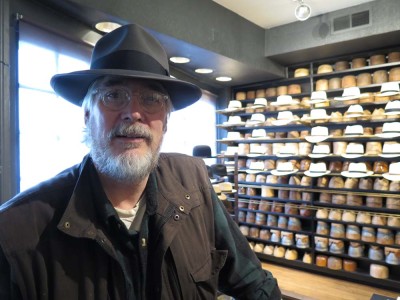
One of these will likely be on my corpse’s head as it is fed into the incinerator before my ashes get scattered on the mountain behind the barn. That’s a proposition that is decades off.
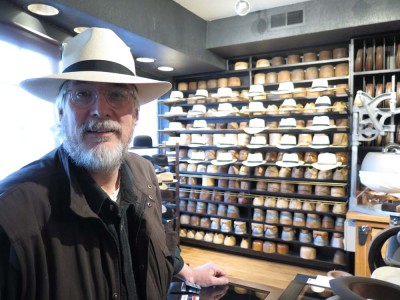
After we left Optimo’s we supped on some of the famous Chicago style pizza, reminiscing on our project, then parted as we each headed for home. His drive was a few minutes, mine was fifteen hours. When parting, Narayan handed me one final gift that in the end allowed the exhibit to be a break-even proposition, demonstrating once again his generous spirit manifest in his time, talents, and treasures.
Great lids, great guy. I look forward to the next time our paths cross, and hope that somehow a project evolves that allows us to work together again.
In addition to my volunteer Heroes for the Studley Collection Exhibit, an almost equal number of “Hired Guns” were on board, people whose services and products were paid for out of exhibit ticket sales proceeds and my own bank account.
In more or less alphabetical order, the Hired Guns were:
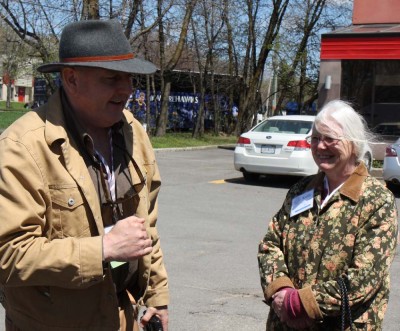
Kathy Donnelly of Martin J. Donnelly Antique Tools — I learned fairly late in the process that simply designating and paying for insurance was not enough once the value of the artwork and collection got to nosebleed heights. It required a valid, legally binding appraisal. Urgently I contacted a number of appraisers I thought might fit the bill, but only MJD Tools stood up the the plate, all the rest chickened out. In a sense it might have been understandable, the Studley Collection had changed hands only once since Henry conveyed it to the Hardwick Family, and that most recent change of ownership had been by private contract. There was no way to truly know the value of this treasure, and except for Kathy and Martin, no appraiser was willing to put their name on such a document. In essence, Kathy and Martin Donnelly put the reputation of MJD Tools on the line for me and you to enable Studley to come before the public eye. There is no way I can truly express my thanks to them for this. And to top it off, Kathy was writing and shepherding the appraisal process right in the middle of one of their humongous tool auctions! Truly, if Kathy Donnelly had not come through, the exhibit would have been cancelled at the last minute, for me a humiliating and reputation destroying catastrophe. I am anticipating with joy the opportunity to look them in the eyes with heartfelt thanks at their July auction, with a hearty handshake for Martin and a fervent hug for Kathy.
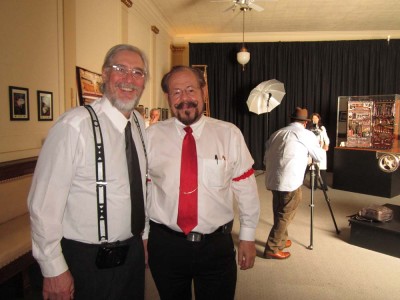
Douglas Heath/Scottish Rite Temple — Truthfully I was torn on whether to include Mr. Heath among the Heroes or the Hired Guns, as he was properly aligned with both. In the end I included him here because as the Registrar of the Scottish Rite Temple of Cedar Rapids, it was he to whom I sent the payment for the exhibit venue. That said, there can be no mistaking his enthusiastic personal support for the project, and no legal length to which he would no go to make the exhibit a success. The set up day on Thursday before the exhibit opened was a perfect case in point. Mr. Heath arrived at the Temple between 6 and 7 AM as normal, yet he stayed with us until the final person departed around 10PM following the evening reception for the Handworks tool makers. And during the event hours, whenever he was not occupied with some other mandatory duty on behalf of the Temple, he was in the gallery looking at Studley along with everyone else.

FedEx Custom Critical Fine Arts Transport aka “The White Gloves Crew” — They got the Studley Collection where it needed to go in perfect condition, ahead of schedule, and on-budget.

With aplomb they nudged the scheduling at my request, understood my changing needs, and responded to them with a timely stream of correspondence and telephone confirmations throughout the entire event. I am not sure I need to elaborate much here.
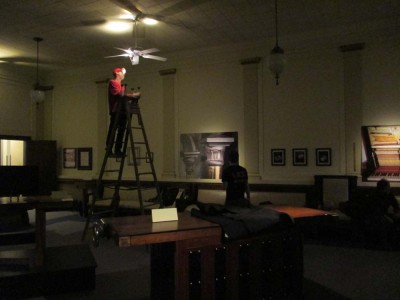
Travis Newell/Unique Events — After the fiasco with the original lighting vendor I was faced with the options of 1) finding a new competent vendor with less than a week to go, and 2) staying up all night for a week fabricating the lighting system. Thanks to the bird-dogging of Jameel Abraham I got in touch with Travis Newel of Unique Events, a mostly wedding and dance party staging company. Museum exhibits was definitely their focus as a business, especially one as idiosyncratic as Studley. I was dubious, but after a lengthy conversation with Travis Thursday evening, a walk-through of the Temple, and a demo at the Unique Events offices, I was convinced. It was clear that Travis and his crew were as passionate about good lighting for events as I was.
They showed up exactly when promised, executed an amazing lighting scheme (drawn almost literally on the back of an envelope) that both highlighted the exhibit yet remained unobtrusive.
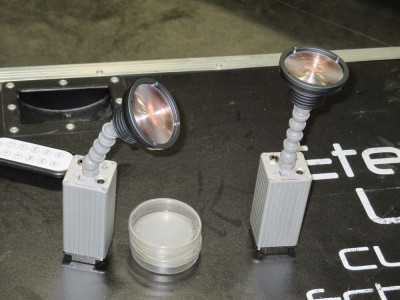
Using magnetic-base battery-powered LED units, they came every morning to mount the lights on the ceiling fan housings, then returned every night to take them back down and get them charged for the next day. Huzzahs all around!
Debby Peak, Senior Vice President, Huntington T. Block Insurance — HTB is a big player in the fine arts insurance world, well known to almost anyone who needs specialized art-based insurance for almost any artifact-related purpose. Miss Peake was terrific at brokering the insurance underwriting, no small task given the odd nature of the need and the tiny size of the exhibit. Our folder of correspondence was substantial, but it worked out exactly as she said it would. Without her, the exhibit could have literally been impossible as Mister Stewart was sensibly not going to allow this treasure to depart from him without the level of insurance coverage he wanted, and rightfully so.

Ramsey Creek Cabinetworks — Josh Yoder‘s crew at Ramsey Creek was the foundation for building the physical infrastructure of the exhibit, the mahogany trimmed vitrine base and the pair of black platform holding the two workbenches. (Josh is in the brown shirt) I sent them specs and drawings, they built them exactly as promised, and delivered them to the Scottish Rite Temple exactly when we needed them as I was composing the exhibit space. Josh also coordinated with Jim Rogers (see below) to make sure the plexiglass case would fit the base precisely. Purrrfect!
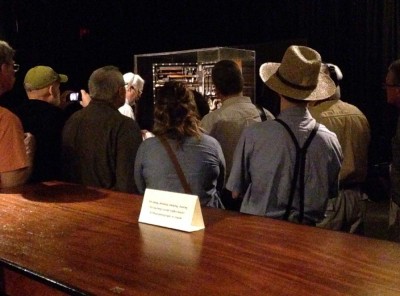
Perhaps my greatest pleasure in my dealings with Josh was when he brought the entire fabrication crew (backs to camera) to the opening session of the exhibit. They were every bit as entranced as the other visitors. As Josh tells the story, the crew was bemused at the prospect of needing an hour to look at “one thing” until the end of their session, when they were begging to stay longer.
Jim Rogers/Plexicraft — When I inquired about getting the plexiglass vitrine fabricated for the exhibit given my peculiar specs for it, almost without fail I got the answer, “There’s this guy in Iowa City who makes medical equipment. Check with him.” Well, “this guy” was Jim Rogers, whose work is primarily the fabrication of ultra precise housings for medical and biology research instruments. The scale and purpose of the exhibit case was way outside his normal range of activities, but when I dropped in to see him last fall he agreed to give it a try. He tried and succeeded. If you were at the exhibit you can attest to the plexiglass case being highly functional and at the same time not overpowering, a sympathetic housing for the contents. Making a display case this large with the complexity required — removing the front at the bottom of every hour so that I could manipulate the contents and make your experience a the richer — was no easy task, but he pulled it off.
==================================
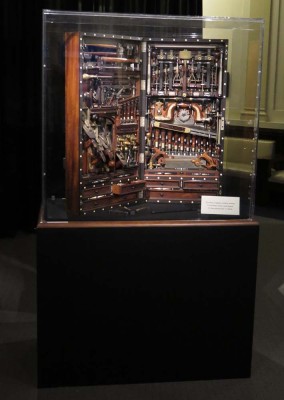
Special Note
Now that the exhibit is finished, and with no plans for anything else similar, I happen to have a superb mahogany-trimmed plexiglass-vitrine exhibit case that is just taking up space in the middle of the shop. If you are interested and need such a piece, let me know. Case contents not included.
===================================
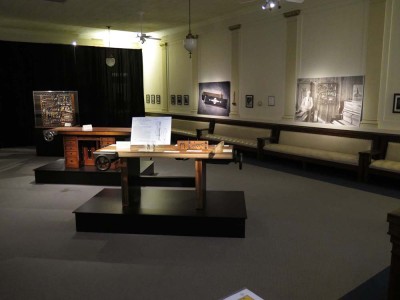
Rapids Reproductions — All those giant panels in the exhibit? Rapids Repro did them. The banners with images of the front cover? Ditto. They did what they said they would do, delivered at the precise time promised, and matching the specs I provided. On budget. ‘Nuff said.
Staples (Staunton VA) — Once we had the tickets designed I simply went to the nearest Staples and handed them the memory stick and stood back. Though he was already clocked out for the evening, the print shop employee remained and got all the tickets printed on the stock I wanted, then trimmed the sheets for me so I could take them all with me instead of having to make a second 100-mile round trip. Little things like that are in fact pretty darned big things when a complex project depends on them.
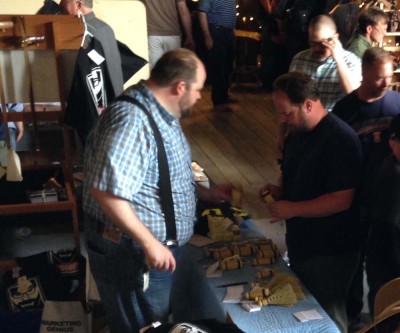
Jason Weaver — Jason came up with a perfect visual design for the exhibit website, and got the site up and kept it running even though the site server got completely smoked during the opening of the ticket sales when over 500 people tried to log on in a fifteen second stretch. That took a little getting over. The mere fact that you had tickets to buy, and a record of that transaction to get you into the exhibit, was all Jason’s doing. Were it up to me, we would still be trying to figure things out.
So there you have it, the Heroes and Hired Guns who were instrumental in making the once-in-a-lifetime exhibit happen.
At the conclusion of the exhibit, you got to go straight home, but I did not. Remaining was the arduous task of examining the artifact components, packing archivally for the trip home, and re-installing the collection back at its home. Then I got to drive the two days back to the Fortress of Solitude.
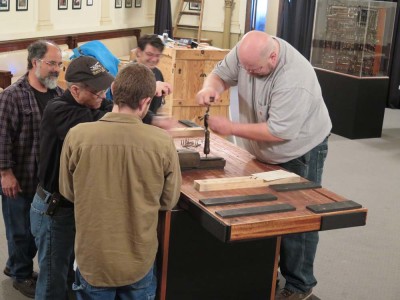
Fortunately for me a sizable cohort of Heroes remained behind for the day of deinstallation, even a second day for loading the crates onto the fine arts transport truck.

The routine of an exhibit de-installation pretty much the reverse of the installation.
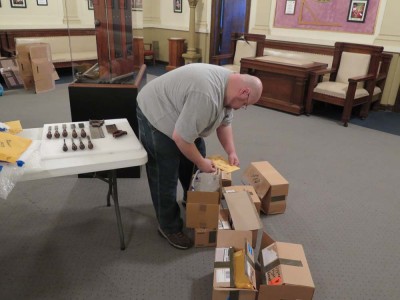
You might think it would go more quickly, but conscientiousness argues the opposite.

For valued treasures, you have to be just as careful disassembling them as you were in assembling them.
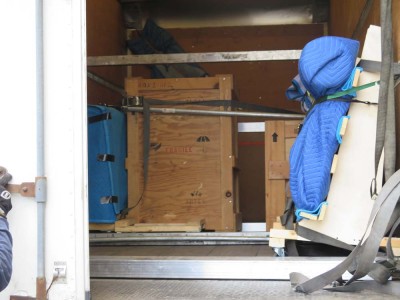
Once again, the collection was loaded and secured onto a dedicated “high security” fine arts transport vehicle. When I say “dedicated” I mean that there was noting else on the truck for either leg of the trip. When I say “high security” you can conclude about that what you want. That type of service is not cavalier, but it is required at this level of the world of artifacts. The insurance underwriters won’t cover it otherwise.
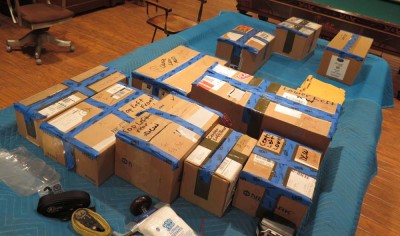

Hours later the collection arrived back at its home, and was unloaded and the crates were rolled into the gallery and left for my ministrations as the transport pulled away. The only thing I wanted accomplished on that day was getting the crates opened and empty, and the cabinet hung on the wall. With that accomplished, along with placing the bench top on the base, the work for the day was finished.


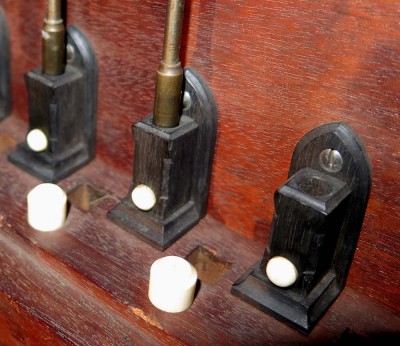
The next morning brought about the installation of the cabinet’s contents. Well, that’s what happened after I spend part of an hour taking one last round of detailed photographs for my own amusement. I intend to integrate many of this detail vocabulary into my mahogany traveling tool case. Stay tuned on that one, as this coming autumn will hopefully bring me time to noodle that exercise.
Each box was emptied and the contents arranged to allow for an inspection, then piece by piece the cabinet contents were placed in their proper location. Because of my recent familiarity with the collection, it actually took only a little more than an hour to load the tools.

On previous visits to the collection, given that they were many months apart, the pace was considerably slower as I had to remind myself each time where things went. Not so this time. Having unloaded and loaded it three times in the previous six days, it went quickly and without a hitch. At noon the final piece was put in its place, and as a nod to my own interest in the mallet as the favorite tool, it was the last thing to go home. Another half hour of clean-up and closing the crates, and I was heading back for home.
The Heroes
Two groups of talented people helped make the Studley Exhibit a reality. In the next blog post I will talk about The Hired Guns, those skilled artists and artisans I hired to complete specific tasks. But for now I’m concentrating on The Heroes, those folks who actually donated their efforts to the cause.
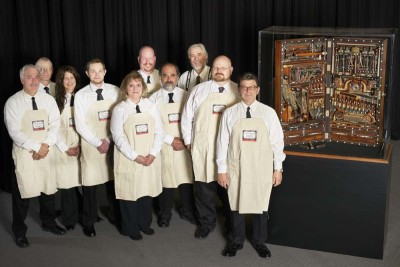
The docent group picture just before the opening reception. From left to right: Bill Robillard, John Hurn, Sharon Que, RickB, Jan Bohn, Sean Thomas, Randy Bohn, Don Williams, Derek Olsen, Mike Mavodones. Not pictured: MikeM1. Photo courtesy of Narayan Nayar.
Notwithstanding the substantial – and some have said excessive – admission ticket price for the HO Studley exhibit, the event was at best a “break even” undertaking (it did not make it there, but I guess that’s why they call it “risk capital”) and could not have come together successfully without a cadre of dedicated volunteer supporters and collaborators.
Yes, The Heroes of the affair were those friends old and new who pitched in and contributed their time, talents, and treasure on your and my behalf to bring HO Studley to you. They gave of themselves most generously, contributing their skills, labors and presence at their own expense to serve as docents and willing hands for the myriad tasks that required conscientious completion. They took vacation, footed their own travel and other expenses, and diligently prepared in advance to provide the patrons with the best possible experience at the exhibit.
As I said earlier the Studley Exhibit was like the tectonic plates of my life colliding, bringing together friends from the museum conservation world, commercial furniture finishing and restoration, and the newer world of Schwarzland. I’d like you to meet them.

RickB during the installation of the exhibit.
I first met RickB when I was doing some guest instructing at the late and much lamented Woodfinishing Program of the Dakota County Technical College (DCTC) just south of St. Paul MN. Rick is perhaps the best natural talent in woodfinishing I have ever met, which irritates me to no end, and he works in the Twin Cities. He drove down to work as part of both the installation and docent crews. And in the past, he spent a couple weekends helping me build The Barn.
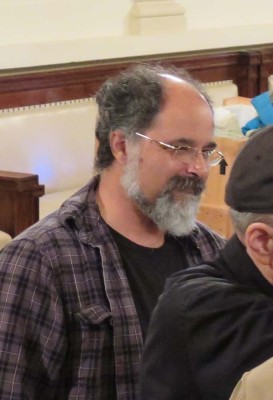
Randy Bohn is a long time acquaintance from Minnesota I first met when I was guest teaching at DCTC. He’s had a long and storied career in antiquities and furniture restoration, and we have become better acquainted only in recent years. JanB is Randy’s wife, and she comes from the business side of the world as she administers a couple of professional organizations. I met her for the first time last year, and she is an unmitigated delight to be around. When I needed a couple of extra docent volunteers late in the game, Jan and Randy jumped right in with enthusiasm and elan.
John Hurn is a small businessman operating his own furniture restoration practice near St. Louis. We met through the on-line discussions and in-person events of the Professional Refinisher’s Group and my forays to teach at the National Woodfinishing Institute in Minnesota. He has been a faithful friend and contributor to my projects in the past, and it was a delight to once again have him on board.
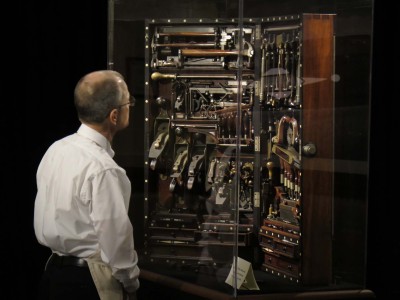
John Hurn admiring the case as intently as did the patrons.
MikeM1 is a long time friend and historic upholstery collaborator, and a driving force behind the Professional Refinisher’s Group on-line forum to which I belong (and you should too!). Mike decided to go “full Hal Holbrook” on us (Holbrook’s portrayal of Mark Twain is one of Mike’s favorites) and came to the exhibit as Henry O. Studley himself, regaling the audiences with yarns about the times and fashions of Studley.
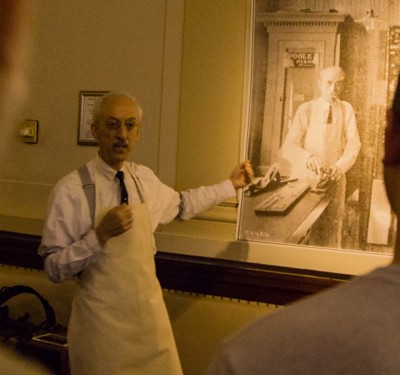
Mike or Henry?
The success of Mike’s portrayal is clearly evident in this image below, where two dozen exhibit patrons are spellbound by him, while only three are looking at the actual cabinet!

Note the crowd size as Mike spins Studleyesque yarns.
Mike Mavodones was first drawn into the Orbit of Studley when he sent me photos of his odd wheel-handled vise. I visited him in Maine and photographed the vise, which eventually was included in the pages of Virtuoso and then loaned it to be included in the exhibit.
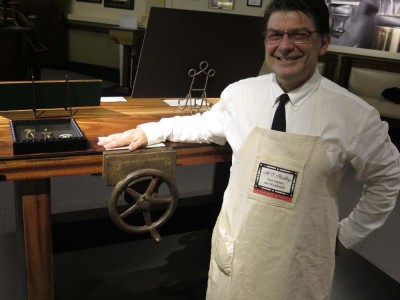
Mike Mavodones alongside his very unusual wheel handled vise. Read about it in Virtuoso.
In addition, he volunteered to serve as a docent, and no one in the hall brought greater appreciation and passion than did Mike.

Sometimes Mike wound up holding the plexi panel for almost a half hour while I waxed ecstatic about the tool cabinet and contents.
Mike was usually the one to assist me in the removing of the plexiglass front for the “open vitrine” sessions. He made his drive from Maine really count. Though a new found friend, Mike was a tremendous contributor to the exhibit as installer, interpreter docent, and de-installer.
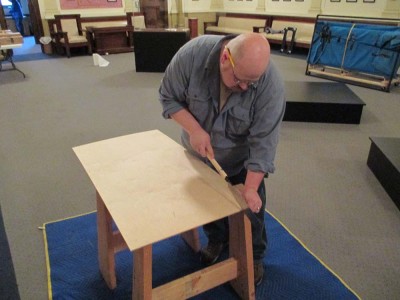
Derek Olsen, perhaps better known to many of you as the “Old Wolf” of the Old Wolf Workshop blog, which is how we met through correspondence relating to his always instructive and inspiring posts. In recent years we have become personal friends, and Derek was on-hand in Cedar Rapids to do anything that needed doing before, during , and after the entire event. He was there when the transport arrived with the collection, and he was there to load it up for return to its home. Throughout the exhibit Derek was my “go to” guy.
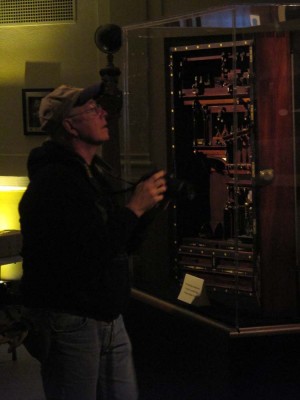
Even after almost five decades of caring for precious historical artifacts RickP couldn’t help but be seduced by the tool cabinet.
RickP is one of my oldest friends, we having first met when he attended workshops I hosted at the Smithsonian three decades ago. A successful fine and decorative arts conservator in northwest Arkansas(!), Rick and I share a passion for history and preserving the artifacts remaining from the past. Rick only had one day to participate in Cedar Rapids, but he drove one day coming and and one day returning home in order to contribute to the installation of the exhibit.
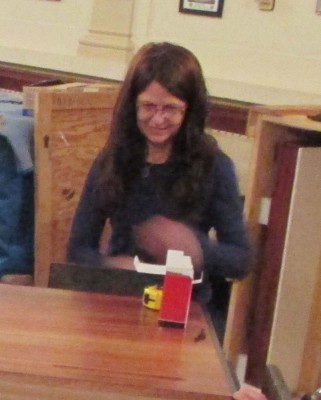
Sharon admiring one of the turn-of-the-century wheel handled vises on the replica bench.
Sharon Que is a renowned violin artisan in Michigan, engaged mostly in restoring violins at the very highest levels as you would expect from a member of the American Federation of Violin and Bowmakers, the nation’s premier organization of that field. She is also a gifted sculptor and active contributor to the Refinisher’s Group. We first met when she wrote to ask about shellac. How can you not find that appealing? It turned out that she was literally on her way through Cedar Rapids at the exact right time to be part of the installation crew and spend a day as docent. Her skills and good cheer make her welcome at anyplace I am.
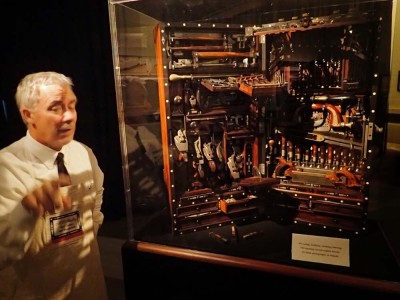
Bill Robillard “walking through” the cabinet history and contents with the guests at the opening reception for the Handworks toolmakers.
Bill Robillard is also a dear friend of many years whom I first met through the Refinisher’s Group and my times at DCTC. A former electrical/robotics engineer, he has twice come to The Barn to help me work on the power system there. Now semi-retired (yeah, he “retired” like I did!) with a furniture preservation practice in Green Bay WI, Bill has helped the entire Studley franchise in innumerable ways, and drove down from Green Bay to be on the installation and docent crews.
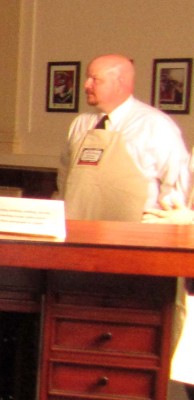
Sean Thomas is a physician from the Orbit of Schwarz. We met first at Handworks 2013, when my compewder threw a tantrum just before the Studley presentation there, and whether by sweet promises or dire threats, Sean got the stupid machine to behave itself. Sean was another volunteer enthusiastic to be part of the history-making experience of bringing Studley to the public, and was part of the project every step of the way. His new friendship is one of the treasures I have collected along the path to this project’s completion.
There are no doubt other Heroes who should be profiled here — my collaborators at LAP, researchers JohnC and ElizabethC, to name a few — but I wanted to put, er, a face on the faces you saw alongside me in Cedar Rapids.
Without them it would not have happened. Thank you all. Your accounts in the First Bank of Don are brimming.
Here iare some more photos from the Gallery of Heroes
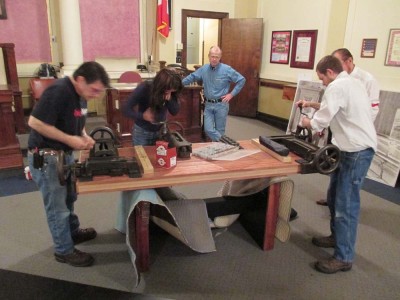
Mike, Sharon, and RickB installing a quarter ton of vises on the replica bench top.

RickP getting the crate with the tool cabinet ready for removing and installing Studley’s masterpiece.
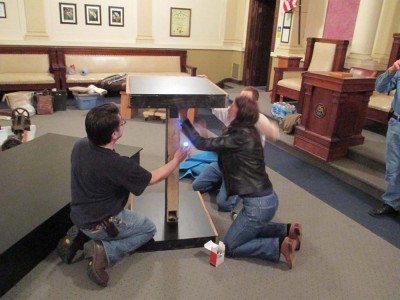
Mike, Sharon, and RickB assembling the replica workbench top’s exhibit stand

Friends old and new enjoying a moment of quiet fellowship during a lull in the proceedings.
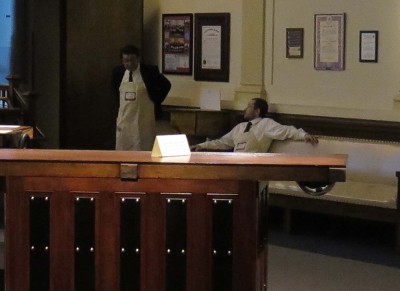
Mike and RickB readying themselves for the wave of Studley fanatics.
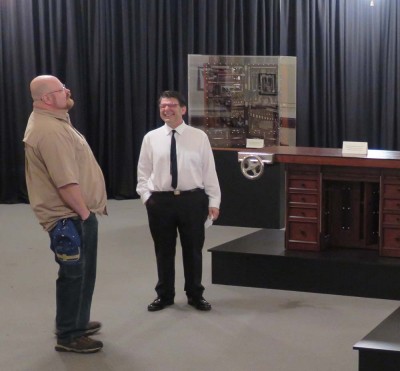
Derek and Mike laughing about something just before the doors opened for the first session on Friday morning.
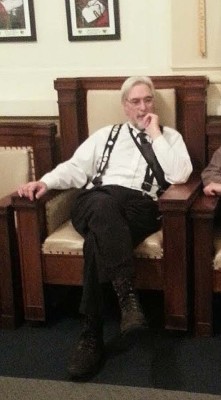
While it seemed to me that the final afternoon of the exhibit The Henry O. Studley Tool Cabinet and Workbench was about four years after it opened at the Scottish Rite Temple, it was in fact only four days after installation. Jameel Abraham’s snapshot of me in the final hours of the show pretty much says it all.
I knew beforehand that Sunday afternoon would be slow; it was after the rush of Handworks so the overall energy level wold be low, plus the tickets for Sunday afternoon just weren’t selling in advance. Going into the weekend, the final three viewing sessions for the exhibit totaled around thirty tickets, as opposed to the 150 visitor slots for those hours.

By lunch time my energy was flagging a smidge, and when I learned that virtually none of the remaining late afternoon tickets had sold at Handworks, I made the executive decision to reward the hearty survivors with the chance of a lifetime. I announced to the audiences and docents that beginning with the 3PM session, anyone who came in could stay until the very end when we kicked everyone out at 6PM.
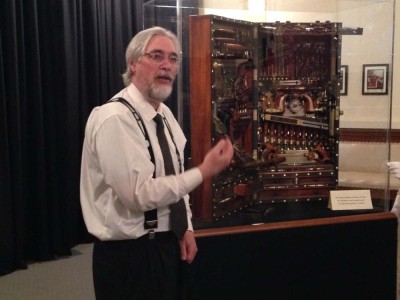
This decision re-energized me for some reason, and I charged into the home stretch with renewed vigor. Yes, I was too weary to stand and speak for the whole afternoon, but I could certainly sit and speak at length and many of the patrons came and sat with me as we spoke.
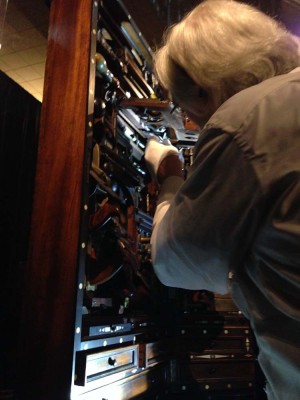
In addition, the “open vitrine” segments got longer and the descriptions and demonstrations more elaborate as we were not facing deadlines of the coming group at the top of next hour. My soliloquys on the cabinet, tools and the tales of HenryO became more “Don-like” as I am wont to take my time in unfolding the narrative under the best of times. And for this afternoon, there was no deadline as the audience and docents knew I wasn’t restricted by time.
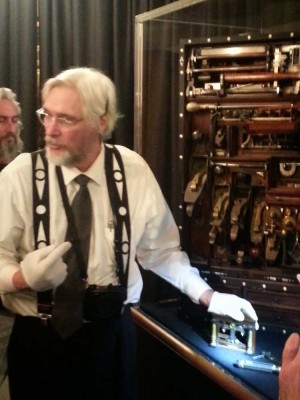
The final “open vitrine” session beginning about 5PM was a thing to behold, as I took the time to guide the two dozen remaining stalwarts through the entire tool cabinet contents, showing each tool, opening each compartment including drawers, and removing many of the tools and inner racks for their viewing pleasure. We kept this up until just before 6PM, when we reassembled the case and vitrine, and wished all the visitors farewell.
Then, all the docents and I went out to dinner. On me.
And it was over.
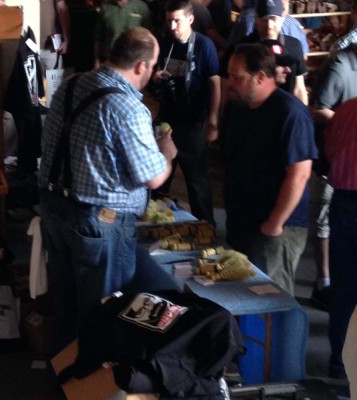
Whilst I was occupied fully at the Scottish Rite Temple in downtown Cedar Rapids, twenty miles away Jason Weaver was acting in my stead sharing a booth with Jeff Hamilton at Handworks. Jason’s task was to hawk polissoirs and related paraphernalia, and move the last 100 or so tickets for the H.O. Studley exhibit.
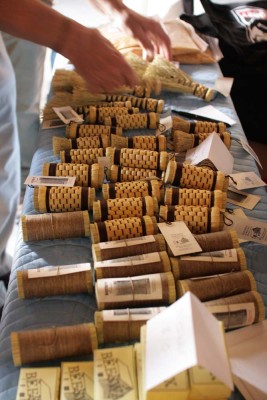
He did better at the former undertaking than the latter. As he told me, almost nobody wanted to wait around until late Sunday afternoon — when most of those tickets were available — and thus he had very little luck in selling them.
If you were one of those folks who didn’t feel like waiting until Sunday afternoon to see the Studley exhibit, too bad for you! The folks who did stick around until the end got the opportunity of a lifetime.
I’ll tell you about it next time. Hint: they got to see everything!

































































Recent Comments